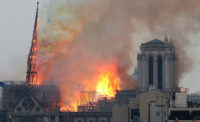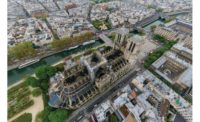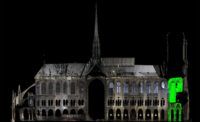Two years after fire swept through the roof of France’s medieval Notre Dame de Paris cathedral, rescue and recovery work is winding down as restoration is set to start this summer. Stone masonry and other traditional crafts will take center stage over the next three years, but digital models of the edifice before and after the fire will guide progress.
Enough data to create a digital twin of the cathedral building was already on the servers of the locally based survey company Art Graphique & Patrimoine (AGP) before the April 15, 2019, fire. To capture the damaged building's geometry, an AGP team completed another survey four days later.
The fire started in the cathedral’s roof, consuming 1,000-year-old oak beams, toppling its 19th century spire and pouring tons of molten roofing lead onto internal stonework vaults. The cause of the fire has still not been determined. Rescue work started the next day and French President Emmanuel Macron promptly set a five-year deadline for the cathedral’s restoration.
Reaction from U.S. software company Autodesk Inc. was just as rapid. As news of the fire spread, Nicolas Mangon, vice president for architecture, engineering and construction design, got a call from company President and CEO Andrew Anagnost instructing him to offer Autodesk resources to the cathedral team.
Mangon, a French citizen, entered the charred building about two weeks after the fire and Autodesk began work on the BIM model a few weeks later. The company is providing models and support resources for the five-year restoration, at no cost to the French authorities, he says.
To achieve his rapid restoration schedule, Macron "had to create a public body [to go] faster than the traditional design, bid, build contract that takes place in France,” says Mangon. Several months later, the restoration program was put into the hands of the newly created public body (EPRNDP) led by Army General Jean-Louis Georgelin, who reports to Macron.
In the months it took EPRNDP to move into action “we already started to build a 3D BIM model of the cathedral,” says Mangon. Autodesk recruited AGP to provide the billions of coordinates in the point cloud representing the cathedral geometry, with the survey firm having accumulated precise data of the cathedral over many years working for the ministry of culture’s regional department, which owns the building.
The post-fire survey “was to see if there had been movement in the structure,” says AGP business development manager Chiara Christarella. Using laser scanners and drone-based photogrammetry, the team completed the survey in one day, generating more than 30 billion data points, in a “commando” operation that would normally have taken a week, according to AGP.
“It was really in a rush,” says Caitlin Roclin, an AGP architect and modeller. Building the BIM model for a stonework structure erected over a period of nearly two centuries starting more than 800 years ago was a challenge, she says. AGP specializes in surveying historic buildings, “but it’s the scale of Notre Dame that’s difficult,” she adds.
Progress Made
Autodesk will continue supporting the restoration until its end, not as a paid supplier but as a patron. Meanwhile, on site, the $200-million rescue phase has gone well, despite the presence of lead, potential structural instability and the pandemic, according to EPRNDP.
By last November, some 40,000 twisted and partially melted scaffolding tubes, previously erected around the spire, had been cut away. The great organ, with its 8,000 pipes, left the site by December.
To stabilize the cathedral structure, external flying buttresses have been propped with timber arches while scaffolding, up to 27 m tall, is being erected inside the chancel, transepts and nave to allow propping of the weakened stonework ceiling.
Meanwhile, 1,000 oak trees have been procured to rebuild the roof, and, after much debate, the decision was made last summer to replicate the 19th century spire rather than erect a modern structure, as had been controversially proposed.










Post a comment to this article
Report Abusive Comment